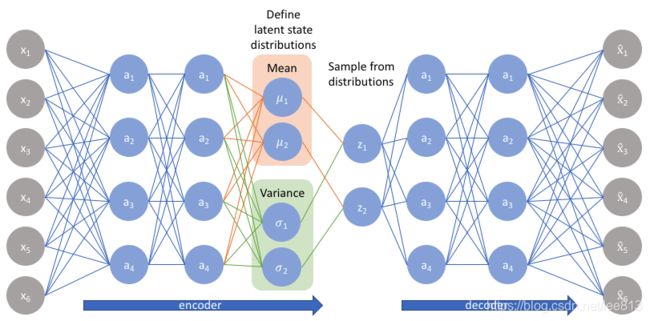Variational Autoencoder 变分自动编码器
一步一步实现一个VAE
大部分来自Keras VAE的教程,不过没有使用mnist,而是用了cifar10的数据集
最简单的两个全链接层的Autoencoder
先贴个代码:
# this is the size of our encoded representations
encoding_dim = 32 # 32 floats -> compression of factor 24.5, assuming the input is 784 floats
# this is our input placeholder
input_img = Input(shape=(784,))
# "encoded" is the encoded representation of the input
encoded = Dense(encoding_dim, activation='relu')(input_img)
# "decoded" is the lossy reconstruction of the input
decoded = Dense(784, activation='sigmoid')(encoded)
# this model maps an input to its reconstruction
autoencoder = Model(input_img, decoded)
# this model maps an input to its encoded representation
autoencoder.compile(optimizer='adadelta', loss='binary_crossentropy')
这里就是把输入层放入一个全链接层,压缩成为一个32维的数组,然后再使用这个32维的数组用一个全链接层去还原原来的图片。
下面这段代码是用来显示效果,这里还是用的mnist的数据集。
encoder = Model(input_img, encoded)
# create a placeholder for an encoded (32-dimensional) input
encoded_input = Input(shape=(encoding_dim,))
# retrieve the last layer of the autoencoder model
decoder_layer = autoencoder.layers[-1]
# create the decoder model
decoder = Model(encoded_input, decoder_layer(encoded_input))
使用多层全链接层的Autoencoder
input_img = Input(shape=(784,))
encoded = Dense(128, activation='relu')(input_img)
encoded = Dense(64, activation='relu')(encoded)
encoded = Dense(32, activation='relu')(encoded)
decoded = Dense(64, activation='relu')(encoded)
decoded = Dense(128, activation='relu')(decoded)
decoded = Dense(784, activation='sigmoid')(decoded)
autoencoder = Model(input_img, decoded)
autoencoder.compile(optimizer='adadelta', loss='binary_crossentropy')
这里使用三层全链接层做encoder,三层做decoder,还是压缩到32维
深度卷积网络来构建的autoencoder
我们在这里用了cifar10作为数据集
input_img = Input(shape=(32, 32, 3))
x = Conv2D(64, (3, 3), padding='same')(input_img)
x = BatchNormalization()(x)
x = Activation('relu')(x)
x = MaxPooling2D((2, 2), padding='same')(x)
x = Conv2D(32, (3, 3), padding='same')(x)
x = BatchNormalization()(x)
x = Activation('relu')(x)
x = MaxPooling2D((2, 2), padding='same')(x)
x = Conv2D(16, (3, 3), padding='same')(x)
x = BatchNormalization()(x)
x = Activation('relu')(x)
encoded = MaxPooling2D((2, 2), padding='same')(x)
x = Conv2D(16, (3, 3), padding='same')(encoded)
x = BatchNormalization()(x)
x = Activation('relu')(x)
x = UpSampling2D((2, 2))(x)
x = Conv2D(32, (3, 3), padding='same')(x)
x = BatchNormalization()(x)
x = Activation('relu')(x)
x = UpSampling2D((2, 2))(x)
x = Conv2D(64, (3, 3), padding='same')(x)
x = BatchNormalization()(x)
x = Activation('relu')(x)
x = UpSampling2D((2, 2))(x)
x = Conv2D(3, (3, 3), padding='same')(x)
x = BatchNormalization()(x)
decoded = Activation('sigmoid')(x)
autoencoder = Model(input_img, decoded)
autoencoder.compile(optimizer='adam', loss='binary_crossentropy')
输入为(32,32,3) 最后压缩到16维。
推理VAE的损失函数
条件: 我们有观察值X,这些值是从隐藏变量(Latent Variable Z)中推理出来的。Z则是从一个先验分布 p θ ( z ) p_\theta (z) pθ(z) 中获取的, θ \theta θ在这里并不知道,需要进行求解
根据贝叶斯定理我们有:
P ( z ∣ x ) = P ( x ∣ z ) P ( z ) P ( x ) P(z|x) = \dfrac{P(x|z)P(z)}{P(x)} P(z∣x)=P(x)P(x∣z)P(z)
但是边际似然函数 P θ ( x ) P_\theta(x) Pθ(x)是不可微的,所以我们不能评价或者对他进行求导,导致其不可倍积分。
边际似然函数求的是在 θ \theta θ被积掉后,所求的变量的概率。
P θ ( x ) = ∫ p θ ( x ∣ z ) p θ ( z ) d z P_\theta(x) = \int p_\theta(x|z)p_\theta(z) dz Pθ(x)=∫pθ(x∣z)pθ(z)dz
所以我们使用变分推断来估计这个分布, EM之类的算法就不适用了。
变分推断需要使用KL散度(KL divergence)即一种来测量两个概率分布的差别的测量。在变分推断中,我们要使用一个简单的分布来逼近真实的分布,而KL散度就是用来测量我们提供的分布跟真实分布差距大小的方法。即:
m i n K L ( q ( z ∣ x ) ∣ ∣ p ( z ∣ x ) ) min KL(q(z|x) || p (z|x)) minKL(q(z∣x)∣∣p(z∣x))
在VAE中,损失函数分为两部分,第一部分是KL散度的损失,他的作用像是一个范式一样来规范求出来的 θ \theta θ。第二部分则是reconstruction error,即重建损失,是自动编码机中的损失,用来衡量建立网络的时候出现的损失。
Reparameterization trick
由于 z∼N(μ,σ),我们应该从 N(μ,σ) 采样,但这个采样操作对 μ 和 σ 是不可导的,导致常规的通过误差反传的梯度下降法(GD)不能使用。通过 reparemerization,我们首先从 N(0,1) 上采样 ϵ,然后,z=σ⋅ϵ+μ。这样,z∼N(μ,σ),而且,从 encoder 输出到 z,只涉及线性操作,(ϵ对神经网络而言只是常数),因此,可以正常使用梯度下降进行优化。


